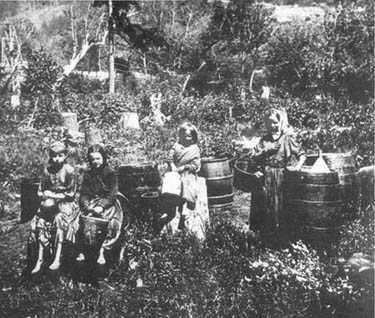 |
||||||
Dippers
Skimming oil from Oil Creek and other water courses was carried out during the 1860's drilling boom. Accidental spills from oil boats happened frequently. Even some creek bank wells initially flowed too strongly (gushers) and lost their first production to the creek. Young and old would dip or skim this oil when the price was high, but most of it was lost and entered the Allegheny River at Oil City and went downstream from there.
 |
Oil dippers on Oil Creek, 1863. Two of the girls are sitting on a barrel. Note buckets. Reprinted by permission of Princeton University Press. |
The dippers used pails, canvas buckets and probably ladles to catch the oil. Barrels would be kept handy and gradually filled. Naturally the dippers had favorite spots on the creek. These would be near obstructions like bridge piers or large rocks. The flat boats, loaded with oil barrels, would ride the crest of a freshet (wave produced by purposely blowing a dam) and vie with one another to gain unobstructed passage to the mouth of the creek. Pileups were common. Barrels would split and bulk boats would spring leaks and, of course, the dippers would be there.
 |
This scene of a pile-up of oil boats in Oil Creek was painted by artist John J. Myers and presented to the Oil City Club by the American Flange and Manufacturing Co., Inc. The smash-up occurred when a flat bottom boat hit the bridge pier in 1864. Barrels spilled oil and tempers were lost. The spectators on the bridge naturally were shouting instructions. Oil dippers would come running, but the real loot was the full oil barrels. |
A windfall could sometimes be made. Full barrels would occasionally fall off a flat boat and make their way downstream. It was fair game to capture a barrel.
A modem version of the "right of capture" happened at Oil City in January, 1996. The ice in Oil Creek broke out upstream and began moving toward a weir. Spilling over the teeth of the weir caused the ice to further break into blocks or bergs. The January thaw also raised the water level in all tributary streams thus putting Oil Creek into an "iceout" and flood condition. Although long accustomed to being buffeted by ice and flood, the exposed creekside basement wall of a brick building on Main Street below the Center Street bridge gave way. The water and ice rushed into a gaping hole and wrested beer kegs from a dealer's storage rooms. The kegs went bobbing down the creek along with the ice cakes and headed for the Allegheny River. Unfortunately for the would-be capturers, the kegs were empty, but you can imagine the story if they had been full.
 |
Creekside of a building on Main Street, downtown Oil City. The ice and flood water of January 18-19, 1996, rose quickly and subsided quickly, but the wall of a beer storage room buckled and the kegs were washed away during the crest. Oil barrels floated on this same stretch of Oil Creek in the 1860's. Photo 1996 by S.T. Pees. |
![]()
| © 2004, Samuel T. Pees all rights reserved |
|